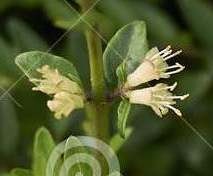Box honeysuckle
(Lonicera pileata yunnanensis)

Description
Lonicera nitida is a species of flowering plant in the honeysuckle family. In English, it is sometimes given the common names box honeysuckle or Wilson's honeysuckle. It is widely used as a low hedging plant, and for topiary. It is also a popular low-maintenance ground cover plant for urban landscaping. The species is native to China, in the area of Yunnan and West Sichuan, where It grows in scrub form along streams at 1,200–3,000 m (3,900–9,800 ft). L. nitida is a broadleaf evergreen shrub 4–5 ft (1.2–1.5 m) tall and 4–6 ft (1.2–1.8 m) wide if unclipped, with dark green, small leaves (6–16 millimeters long). The creamy white, fragrant flowers, appearing at the end of spring, are 6 millimeters long, and grow in pairs. The fruit (rarely formed on clipped specimens) is an inedible bluish-purple berry about 6 millimeters in diameter. The stems are layered one on top of the other giving the appearance of a haystack. The growth rate is moderate or fast growing. While resistant to deer and rabbits, it is attractive to birds. When planted, the species is easy to clip and needs frequent clipping because it flops if it grows to a height over 5 feet. The species is commonly confused with Cotoneaster species. The difference between the two is that Cotoneaster has alternate leaves while this species has opposite leaves. Honeysuckles are arching shrubs or twining vines in the family Caprifoliaceae, native to northern latitudes in North America and Eurasia. Approximately 180 species of honeysuckle have been identified in North America and Eurasia. Widely known species include Lonicera periclymenum (common honeysuckle or woodbine), Lonicera japonica (Japanese honeysuckle, white honeysuckle, or Chinese honeysuckle) and Lonicera sempervirens (coral honeysuckle, trumpet honeysuckle, or woodbine honeysuckle). L. japonica is an aggressive, highly invasive species considered a significant pest on the continents of North America, Europe, South America, Australia, and Africa. Some species are highly fragrant and colorful, so are cultivated as ornamental garden plants. In North America, hummingbirds are attracted to the flowers, especially L. sempervirens and L. ciliosa (orange honeysuckle). Honeysuckle derives its name from the edible sweet nectar obtainable from its tubular flowers. The name Lonicera stems from Adam Lonicer, a Renaissance botanist.
Taxonomic tree:







